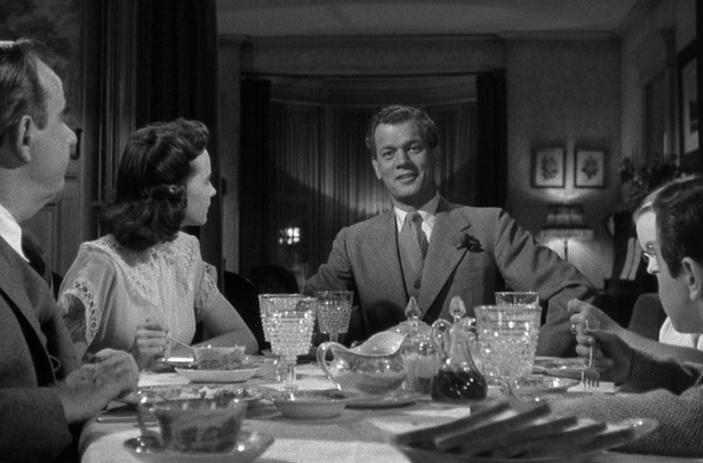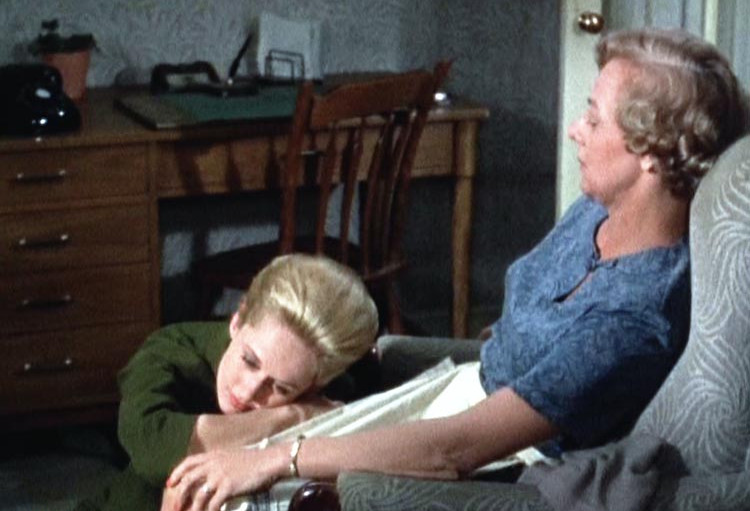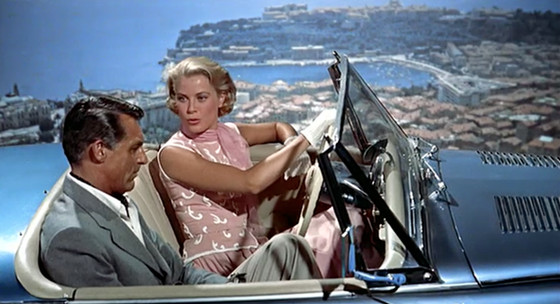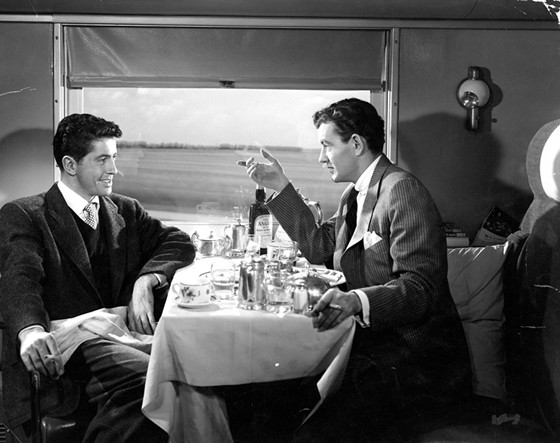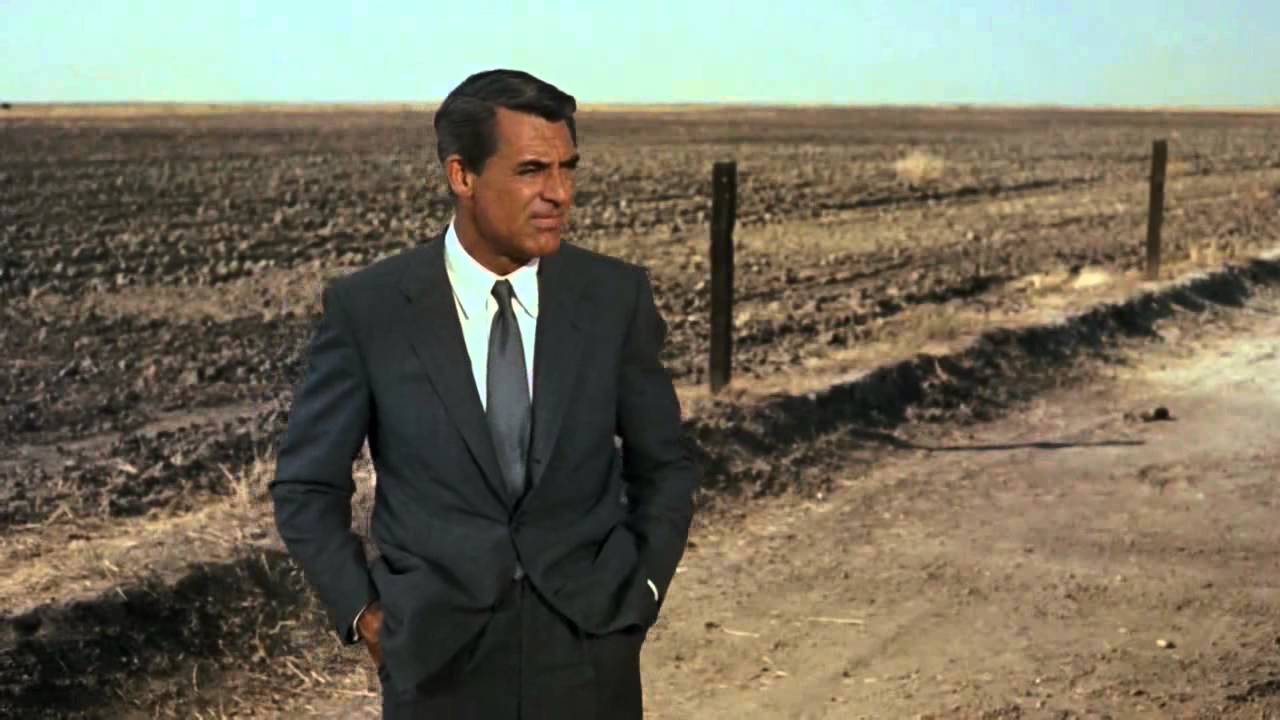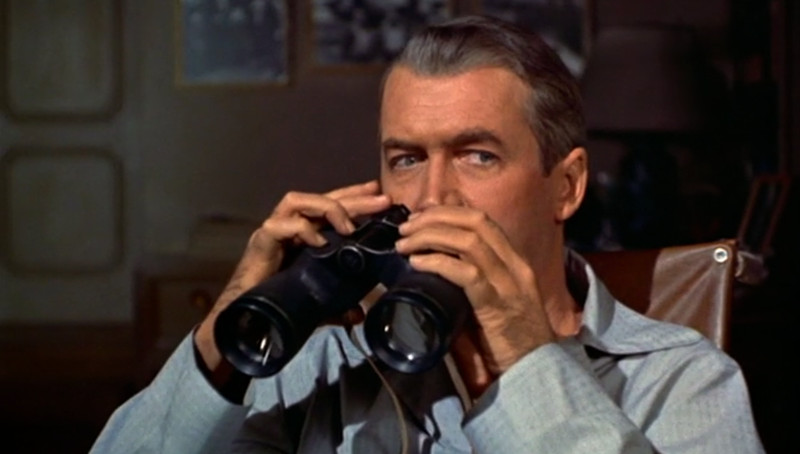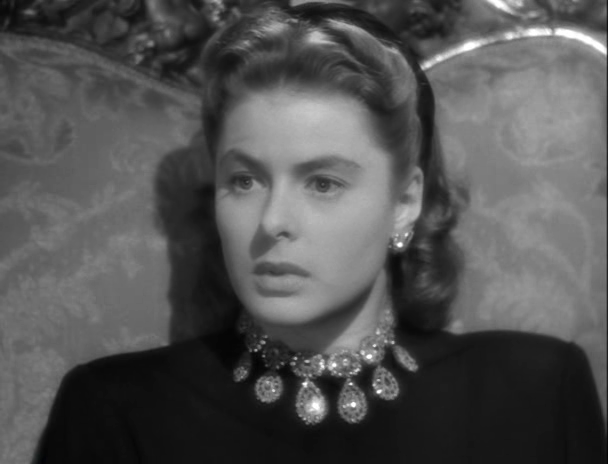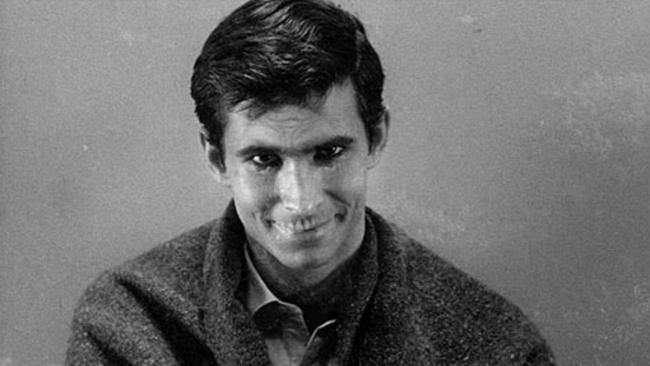8. Joseph Cotten as Charles Oakley in Shadow of a Doubt (1943)
Cotten began his acting career on the Broadway stage and in radio, meeting wonder kid Orson Welles and becoming part of his Mercury Theater. After starring in The Philadelphia Story with Katherine Hepburn, Cotten came to Hollywood where Welles featured him in both Citizen Kane (1941) and The Magnificent Ambersons (1942).
Hitchcock then cast Cotten as Charles Oakley, the psychopathic ‘Merry Widow Murderer’, who comes to small town Santa Rosa to escape the police and hide out in the bosom of his family. But when Charles’ beloved niece Charlie (Teresa Wright) discovers his secret, Charles faces off with her in a battle of wills that ends up being a struggle to the death.
As Charles, Cotten is at times both charming and threatening in Shadow of a Doubt. The townspeople of Santa Rosa, not knowing his true nature and intent, embrace Charles as one of their own and toast him after he has given a speech to the ladies’ club. But to Charlie, who realizes what he has done, her uncle changes from a figure of love and affection to the epitome of evil. She finally struggles with him on the train out of town and has to kill him with her own hands in order to rid the world of the malevolence of Charles Oakley.
Without Cotten’s outstanding performance, the film would not have had near the impact that it did, as it became one of Hitchcock’s best remembered films. Cotten went on to a stellar Hollywood career, including roles in Duel in the Sun, Portrait of Jennie, The Third Man and Niagara. Cotton suffered a major stroke in 1981 which incapacitated him, and although he eventually recovered he finally passed away in 1994 at the age of 88.
7. Tippi Hedren as Marnie Edgar in Marnie (1964)
Hedren was a fashion model who was famously discovered by Hitchcock when he saw on a TV commercial for a diet drink and decided to test her for a part in his new film, The Birds. She won the part of Melanie Daniels and despite enduring an arduous shoot for the film as well as an increasingly uncomfortable relationship with the director, she signed on to play the lead in Marnie, a part that had originally been considered as a comeback role for Grace Kelly.
Marnie is a very problematic character, a kleptomaniac who is frigid and cannot stand to be touched by a man as a prelude to sex. Still somewhat inexperienced as an actress, Hedren gave a performance as Marnie that is nothing short of brilliant.
Marnie is a character who has been deeply traumatized by her past and, instead of overacting, Hedren’s restraint in playing Marnie worked very much in her favor. Unable to tap into emotions that have been deeply scarred by a childhood incident when he mother was a prostitute,
Marnie is frozen in a state of psychological distress. Hedren stated that it was very difficult to play a woman who was unable to have sex with her husband, who was played by sex symbol Sean Connery, but she managed to pull it off and even handle the difficult rape scene that Hitchcock insisted on having in the film.
In the end, Marnie was received indifferently by audiences and Hedren’s film career soon floundered, but she persevered nonetheless, appearing in numerous films and television shows over the years.. Her daughter, Melanie Griffith, became a major star in the late 1980’s and Tippi Hedren now operates the Shambala preserve, dedicated to the protection of endangered species.
6. Grace Kelly as Francie Stevens in To Catch a Thief (1955)
Kelly came from an affluent Philadelphia family, beginning her career as a model, but moving into acting in the early 50’s in films such as Mogambo and High Noon. To Catch a Thief was her third film for Hitchcock, and she portrayed a young woman not unlike herself, who was traveling with her well to do widowed mother in the south of France.
When a jewel thief strikes and former thief John Robie (Cary Grant) falls under suspicion, he contacts Francie and her mother (Jessica Royce Landis) in order to lure the real thief into a trap. Francie is attracted to Robie, but when her mother is robbed she accuses him of the theft although, like many women in Hitchcock, she comes to believe in his innocence and helps him snare the real thief by the film’s end.
As Francie, Kelly is the classic ‘Hitchcock blonde’; she is at first aloof and distant from Robie but, when he accompanies her to her room in the hotel on the first night of their meeting, she suddenly steps in and gives him a big kiss as he says good night. Francie is coy and flirty with Robie in the early scenes of the film as they drive in the hills above Monaco and have a picnic lunch. But her flirtations turn to outrage when her mother’s jewels are stolen, and Robie has to work hard to win back her trust as she helps him to eventually catch the real thief.
Showing a range of emotions with class and style, Grace Kelly gives a wonderful performance in To Catch a Thief, one that neither Hitchcock or his audience could ever forget. Grace married Prince Ranier the next year and went to Monaco as a real princess and though her life ended prematurely in a 1982 car crash, her great film roles of the 1950’s would make her immortal in the eyes of many.
5. Robert Walker as Bruno Antony in Strangers on a Train (1951)
Walker was a talented actor whose first wife, Jennifer Jones, had left him after an affair with producer David Selznick, whom she subsequently married. Walker, who had previously played mostly ‘boy next door’ types, turned to alcohol after his divorce from Jones and began to be plagued by psychological problems. In 1951, Hitchcock cast him as Bruno Anthony, the psychotic playboy who murders the estranged wife of Guy Haines (Farley Granger) in Strangers on a Train.
As Bruno, Walker begins to stalk the hapless Guy after the murder of Miriam, relentlessly pursuing him in an effort to get the tennis player to murder Bruno’s hated father.
Walker played the part of Bruno brilliantly, breaking out of the mold of simplistic characters he had played while under studio contract in the 1940’s and developing a complex, multilayered character whom the audience comes to both love and hate. In one memorable scene, he pops the balloon of a small boy who is irritating him, although later on he shows his good side by helping a blind man across the street. He taunts Guy with the evidence that he has, threatening him that he will return to the scene of the crime to frame Haines for the murder unless he cooperates.
Guy and Bruno engage in a struggle between good and evil that finally culminates in their battle on the runaway carnival carousel, ending in Bruno’s death. Sadly, the troubled Walker died shortly after the film finished its production and so was unable to cash in on the success of the film and his outstanding performance, but his turn as Bruno Anthony will be forever remembered by film buffs and Hitchcock fans alike.
4. Cary Grant as Roger O. Thornhill in North by Northwest (1959)
Born Archibald Leach, Grant had a troubled youth and first came to America with a British vaudeville troupe but ended up staying behind when they went home. By the 1930’s, Grant had moved to Hollywood and quickly established himself as a leading comedic actor in such films as Bringing Up Baby and The Philadelphia Story.
Grant starred in his first role for Hitchcock in Suspicion (1941) and by the time of North by Northwest, his suave image and persona were well established. As Roger O. Thornhill, Madison Ave. executive mistaken for a government agent, Grant is fun to watch while he dodges danger and the police while romancing Eve Kendall (Eva Marie Saint) aboard a train.
But beyond the fun, Grant was able to convey much about the false life lived by glib playboys such as his character in the film. Roger O. Thornhill, whose most enduring relationship seems to be with his overbearing mother, must come to grips with the superficiality of his life when his world is thrown into tumult by Vandamm (James Mason) and his associates. By overcoming the danger that he faces and risking it all to save his new love Eve,
Thornhill realizes that he has a depth of personality that he did not have at the film’s start. Grant played the part with his usual style, making it all look so easy when what he was doing was really very difficult. North by Northwest was a career peak for Cary Grant, and he eventually retired from films in 1966 after the birth of his only child, Jennifer. Twenty years later, he passed away in 1986 at the age of 82.
3. James Stewart as L.B. Jeffries in Rear Window (1954)
L.B. Jeffries is a photographer who loves his life as an adventure seeker, but as Rear Window begins, he finds himself cooped up in his Greenwich Village apartment with his leg in a cast. Under pressure from his attractive girlfriend, Lisa Fremont (Grace Kelly) to settle down and live in New York, Jeffries begins to look into the windows of his neighbors, where he sees a myriad of lives that seem to reflect back on his own relationship with Lisa.
Finally, Jeffries suspects his neighbor, Lars Thorwald, of murdering his invalid wife and he persuades Lisa to help him investigate. But when Lisa goes into Thorwald’s apartment to try to find his wife’s wedding ring as evidence, he must look on in anguish as the man returns to find Lisa there and he proceeds to assault her.
As L.B. Jeffries, Stewart had to convey a range of emotions through the course of the film. Initially merely bored and somewhat indifferent to his neighbors, he becomes highly suspicious of Thorwald and must convince everyone in his life that Mrs. Thorwald has been murdered. Finally, he is racked with guilt and worry when Lisa puts herself at risk in Thorwald’s apartment, then ultimately he must fight for his own life when the killer enters his apartment. Rear Window became one of Hitchcock’s most iconic films and Stewart’s great performance as L.B. Jeffries went a long way in helping the film succeed.
Stewart completed the decade of the 1950’s as one of Hollywood’s most successful leading men before moving into more grandfatherly roles in the 1960’s and ’70’s. He continued to act on and off through the 1980’s and finally passed away in 1997 at the age of 89, acknowledged as one of filmdom’s greatest actors.
2. Ingrid Bergman as Alicia Huberman in Notorious (1946)
Bergman was a successful Swedish actress who came to America in 1939 to star in a Hollywood remake of Intermezzo for producer David Selznick. Bergman quickly became a leading actress in films such as Casablanca (1942) and Gaslight (1944). Her first role for Hitchcock came in the psychological drama Spellbound (1945) and the director cast her again the next year as playgirl Alicia Huberman, who flies down to Rio with American agent T.R. Devlin (Cary Grant) in order to infiltrate a ring of Nazis who were former associates of her father’s.
Alicia and Devlin quickly fall in love, although Devlin is skeptical that Alicia has given up her former partying ways and is ready to settle down with him. Their love is tested when Alex Sebastian (Claude Rains) falls for Alicia and asks her to marry him, and she agrees to become the Nazi’s wife.
Notorious required Bergman to give one of her most sensitive and thoughtful performances in order to be believed as Alicia, who gives up her life as a party girl to sacrifice for her country and make up for her father’s treason. Alicia becomes frustrated trying to melt the cold and disapproving exterior of Devlin, and nobody can blame her for agreeing to marry Alex, who is much more ardent in his pursuit of the woman.
Finally, Alicia falls under the threat of poisoning by Alex and his mother when they realize that she is a double agent, only to be rescued at the last minute by Devlin who has come to his senses at last. Bergman gave another great performance for Hitchcock in Under Capricorn in 1949, but in 1950 she went off to Italy and married Roberto Rossellini. She eventually resumed her Hollywood career, winning her second Academy Award for her comeback film, Anastasia. Considered one of the greatest actresses of all time, Bergman passed away in 1982 on her 67th birthday of cancer.
1. Anthony Perkins as Norman Bates in Psycho (1960)
Robert Bloch’s original conception of Norman Bates was as a middle aged tubby, but Hitchcock rethought the part and cast Perkins, who was at that time something of a teenage heartthrob. As a result, the audience reaction to Norman’s crimes is complicated by the presence of an actor who heretofore had mostly appeared in romance films such as Desire Under the Elms and Tall Story.
When Norman first appears in Psycho as the lonely proprietor of the Bates Motel, Marion Crane (Janet Leigh) views him mostly as the sympathetic victim of a domineering mother figure. But in their parlor conversation, Norman reveals himself to be living dangerously close to the border of sanity, as he reacts harshly to Marion’s suggestions about his mother. Perkins handled the difficult part brilliantly, convincing the audience on one hand that he was the classic mama’s boy while on the other hand turning into a psychotic killer when he was threatened..
As the noose tightened around Norman Bates, Anthony Perkins was able to keep the audience guessing about who was really up in the window of that gothic home behind the motel. Perkins’s creepy performance was one for the ages, and he created a character in Norman Bates (with the help of Hitchcock and screenwriter Joseph Stefano) that would live on for decades. In the final shot of the film, Norman’s transformation is complete and he has ‘become’ his mother, and the great acting performance of Anthony Perkins made this all believable and shocking to audiences.
Although Perkins found himself somewhat typecast as a psycho after the film came out, he continued on with his career, appearing in a number of provocative films in the 1960’s and 70’s such as The Trial, Catch-22, The Life and Times of Judge Roy Bean and Murder on the Orient Express, as well as numerous Broadway performances.
In the 1980’s, he revived the character that had made him famous in several Psycho sequels before he passed away from an AIDS related illness in 1992 at the age of 60. Anthony Perkins appearance in Psycho was a one of a kind performance that had a huge impact on his career and helped Hitchcock to achieve his greatest success.
Author Bio: Jim Davidson is a 1980 graduate of Northwestern University’s Radio-TV-Film Dept. He lives in the San Francisco Bay Area and has been a video producer since 1987. Jim has written articles for Images Film journal and his book, When Harold Met Maude: Hal Ashby and the Making of Harold and Maude, will be published shortly by McFarland & Company.
